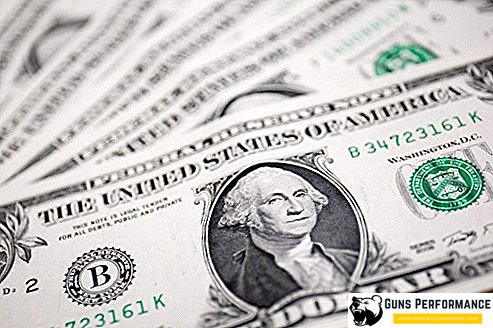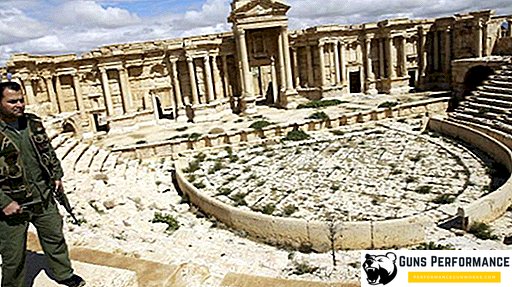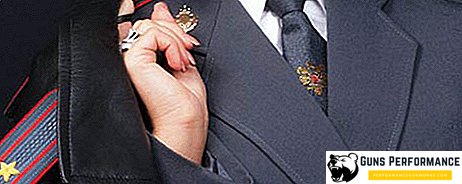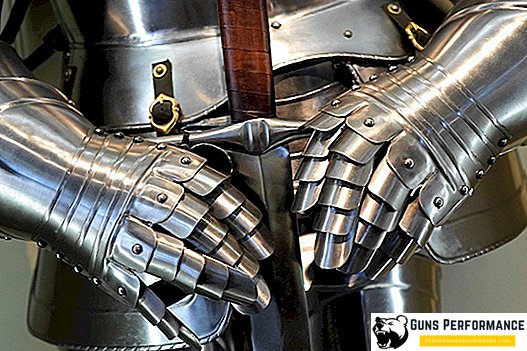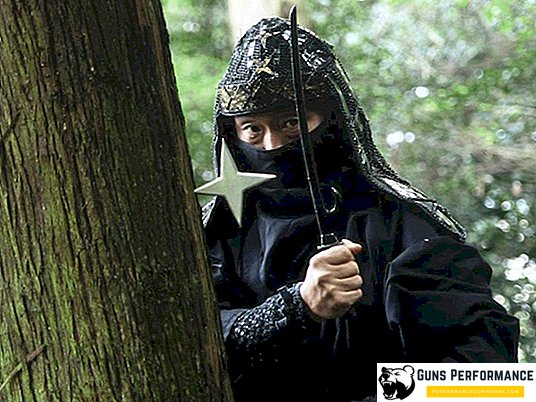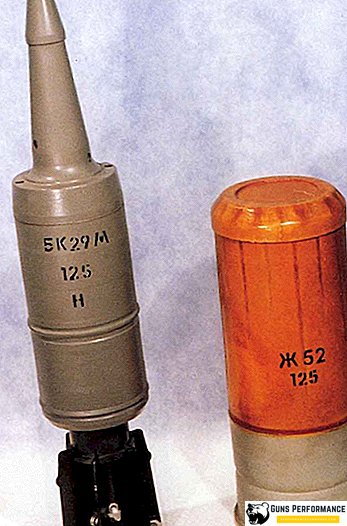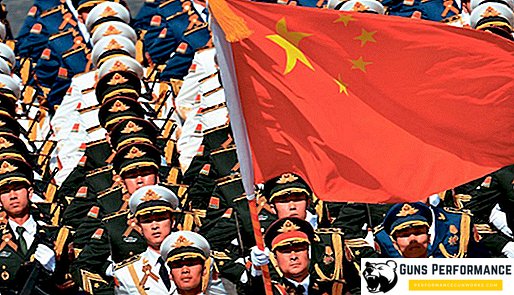
A noticeable geopolitical tendency of the last decades was the rapid strengthening of China and its gradual transformation from a regional leader into a superpower, which no longer conceals its global ambitions. Today, the PRC has the second economy in the world, and it continues to grow rapidly; more than a third of the growth of world GDP is provided by China.
However, for the realization of global ambitions, a powerful economy is not enough. The power of the state and the respect of its neighbors - as at all times - is determined by the ability of its armed forces to defend national interests.
It should be noted that the estimates of the Chinese military power are very different. From panic materials about the "yellow" threat capable of capturing the whole world, to the frankly dismissive attitude towards the development of the Chinese military-industrial complex. But still, most experts recognize the successes achieved by the Chinese military leadership in recent years. So, what is the modern army of China? Should I be afraid of her?
The country's armed forces bear the official name of the PLA, the People’s Liberation Army of China, they were founded on August 1, 1927 during the civil war, but this name was received somewhat later, after the end of the Second World War. Today, the PLA is considered one of the strongest armies on the planet, experts put it on the second or third place in the ranking of the armed forces of the countries of the world.
In accordance with the country's constitution, the PRC army is not subordinate to the government or the leadership of the Communist Party, but to a special body — the Central Military Council. The post of chairman of the Center is considered one of the key ones in the hierarchy of power, currently (since 2013) he is occupied by the General Secretary of the CPC Central Committee Xi Jinping. The first chairman of the Central Military Council was Deng Xiaoping, one of the architects of the Chinese economic miracle.

As of 2013, the number of PLA was 2 million 250 thousand people (according to other data - 2.6 million). In 2016, the next reduction of the armed forces of China by 300 thousand people was announced. After the implementation of these plans in the Chinese army will remain approximately 2 million people.
The Chinese army is a draft, men are recruited for service in the armed forces at the age of 18 and remain in reserve for up to 50 years.
China continues to increase defense spending: if at the beginning of the 2000s, the country spent $ 17 billion on the army and the military industrial complex, in 2013 this figure reached $ 188 billion (2% of GDP). In terms of military expenditures, the PRC confidently ranks second, having overtaken Russia considerably (with its $ 87.8 billion in 2013), but more than three times behind the United States ($ 640 billion).
It should be noted, and the impressive success of the Chinese defense industry. You can forget the times when the word "Chinese" was synonymous with something cheap, low-quality and counterfeit. Today, China produces almost the entire range of weapons and ammunition. If earlier China basically copied Soviet and Russian models of weapons, then today the Chinese "defense industry" is trying to imitate the most technologically advanced products from the USA, Europe and Israel.

China is still lagging behind Russia in some areas: in aviation and rocket engines, submarines, cruise missiles - but this lag is rapidly narrowing. Moreover, China is gradually turning into a powerful player in the global arms market, confidently occupying the niche of low-cost and high-quality weapons.
PLA History
The history of the Chinese armed forces has more than four thousand years. However, the modern army of the People's Republic of China is the heir to the pro-communist armed groups that emerged during the civil war that took place in the country of the 1920s-1930s. On August 1, 1927, an uprising began in the city of Nanchang, during which the so-called Red Army was founded under the leadership of the future leader of China, Mao Zedong.

The Chinese Red Army fought against the Kuomintang armed forces, then fought against the Japanese invaders. It received the PLA name only after the end of the Second World War.
After the defeat of the Kwantung Army, the USSR handed over all Japanese weapons to its Chinese comrades. Chinese volunteers armed with Soviet weapons actively participated in the Korean War. The Soviet Union actively helped China build a new army, and very quickly numerous and fairly efficient armed forces were established on the basis of semi-partisan units.
After Stalin’s death, relations between the PRC and the USSR began to deteriorate rapidly, and in 1969 there was a border conflict on Damanski Island, which almost turned into a full-scale war.
Since the 1950s, the PLA has undergone several significant reductions, the most significant of which were carried out in the early 1980s. Until that time, the Chinese army was mostly land, it was "sharpened" for a possible conflict with the USSR. After the likelihood of war in the north declined, the Chinese leadership began to pay more attention to the south: Taiwan, disputed territories in the South China Sea.
In the 90s of the last century, the leadership of the PRC began a program to modernize the national armed forces, which led to such impressive growth in the future. More attention has been paid to the development of the navy, missile forces and the air force.
A few years ago, the start of a new reform of the PLA was officially announced. Conversions are already underway. The principle of the formation of the armed forces of the armed forces has changed, new types of troops have been created. The goal of large-scale transformations is to achieve a new level of PLA controllability by 2020, optimize the structure of the army and create armed forces capable of winning in the era of information technology.
PLA structure
The power system of modern China provides for full control of the national armed forces on the part of the country's ruling Communist Party. Each level of PLA organization has its own party control structures. It should be noted that in comparison with the middle of the last century, the influence of the party leadership and ideology on the armed forces became less.
The main governing body of the PLA is the Central Military Council, it consists of the chairman, his deputy and members of the council, and military personnel. China also has the Ministry of Defense, but its functions are minimized: to the organization of international military cooperation and peacekeeping missions.
The reform launched in 2016 primarily affected the PLA management system. Instead of four headquarters — the General Staff, the headquarters of the rear, the main political department and the arms department — fifteen compact departments were created, each of which deals with a separate direction and reports to the Central Military Council.

The reform also affected the structure of the Chinese armed forces. A new type of military force appeared in the PLA - the Strategic Support Forces, a reformatting of the country's military districts was carried out. Formerly, the territory of China was divided into seven military districts, on February 1, 2016, they were replaced by five zones of military command:
- Northern zone of military command. Its headquarters is in Shenyang. The command structure includes four army groups. Its main task is to counter the military threat from North Korea, Mongolia, northern Japan and Russia.
- Western zone of military command (headquarters in Chengdu). Controls most of the country, but does not have access to the sea. The task of the command is to ensure the security of Tibet, Xinjiang and other areas. The most important for China is the Indian direction, for which the Western command is also responsible. It consists of three army groups and about ten separate divisions.
- South military command zone (headquarters in Guangzhou). Controls the territory near the Vietnamese, Laotian and Myanmar borders, it consists of three army groups.
- Eastern military command zone (headquarters is in Nanjing). One of the most important areas for China, given the long-standing problem with Taiwan. The Chinese do not exclude the possibility of its solution by military means. The command structure consists of three army groups.
- The central military command zone (headquarters in Beijing). This command protects the capital of the country - Beijing, it includes at once five army groups, so the Central Command can be called strategic for the armed forces of the PRC.
Currently, the PLA includes five types of troops:
- Ground troops;
- Navy;
- Air Force;
- Strategic Missile Forces;
- Strategic support troops.
PRC ground forces

China has the largest land army in the world. Experts estimate its number in 1.6 million people. It should be noted that the current reform of the PLA provides for a significant reduction in the Ground Forces. Currently, the Chinese army continues the transition from the divisional to a more flexible brigade structure.
The reserves of the Ground Forces are estimated at about 500 thousand people. At least 40% of the Chinese army is mechanized and armored.
Currently, there are more than eight thousand tanks in service with the PLA, among which are both obsolete (various modifications of the Type 59, Type 79 and Type 88 tanks) and new ones: Type 96 (various modifications), Type-98A, Type-99, Type-99A. The ground forces of the PLA also have 1,490 infantry fighting vehicles and 3,298 armored personnel carriers. There are more than 6 thousand towed guns, 1,710 self-propelled howitzers, almost 1,800 MLRS and more than 1,5 thousand anti-aircraft guns in operation.
One of the main problems of the Chinese army (including the Ground Forces) is the amount of outdated equipment and weapons, which was developed on the basis of Soviet designs at the end of the last century. However, this issue is gradually being solved, and the troops are saturated with modern types of weapons.

Air Force
The PRC's air force is in third place in the world (390 thousand people (according to other sources - 360 thousand), second only to the USA and Russia. The air force is divided into 24 air divisions. There are about 4 thousand combat aircraft of different types , models and destinations, as well as more than a hundred military helicopters.The Chinese air force also includes air defense units, armed with about 700 launchers and 450 radars of various types.

The main problem of the Chinese Air Force is the operation of a large number of obsolete vehicles (analogs of the Soviet MiG-21, MiG-19, Tu-16 and Il-28).
Serious modernization of the Chinese Air Force began at the end of the last century. China has bought dozens of the latest Su-27 and Su-30 aircraft from Russia. Then, in China, the licensed production of these machines began, and then unlicensed.
From about the middle of the last decade in China, they have been developing their own fifth-generation fighter jets: the J-31 and J-20. The J-20 fighter was demonstrated to the public last fall. The plans of the Chinese leadership are not only to equip their own air forces with these machines, but also to actively export them.

PRC Navy
Until the early 1990s, relatively little attention was paid to the development of the naval forces in China. This type of troops was considered auxiliary, but since then the situation has changed dramatically. The PRC leadership understood the importance of the Navy and does not spare resources for its modernization.
Currently, the number of Chinese Navy is 255 thousand people (according to other sources - 290 thousand). The Navy is divided into three fleets: the Southern, Northern and Eastern Seas, respectively. The fleets are armed with surface ships, submarines, naval aviation, marine units and coastal defense forces.

In 2013, the PLA General Staff Chief stated that the main threats to modern China come from the sea, so the development of the Navy is a priority.
Rocket troops
Prior to the reform, the Chinese Strategic Missile Forces were called the Second Artillery Corps, and only in 2016 did they receive a new status. Their number is about 100 thousand people.
The number of nuclear warheads that China currently has raises many questions. Experts estimate their number from 100 to 650 pieces, but there is another opinion that over several decades, China could produce several thousand nuclear warheads.

The Americans believe that by 2020, China will be able to put on combat duty up to 200 ICBMs (both mine and mobile), equipped with combat units of a new generation. Of particular note is the latest Chinese missile systems "Dunfyn-31NA" (range 11 thousand km) and Dunfang-41 (14 thousand km).
Strategic support troops
It is the youngest of the armed forces of the Chinese army, it appeared on December 31, 2016. Information about the goals and objectives of the Strategic Support Forces is very small. Announced that they will be engaged in intelligence, information war, conducting attacks in cyberspace, electronic countermeasures.



